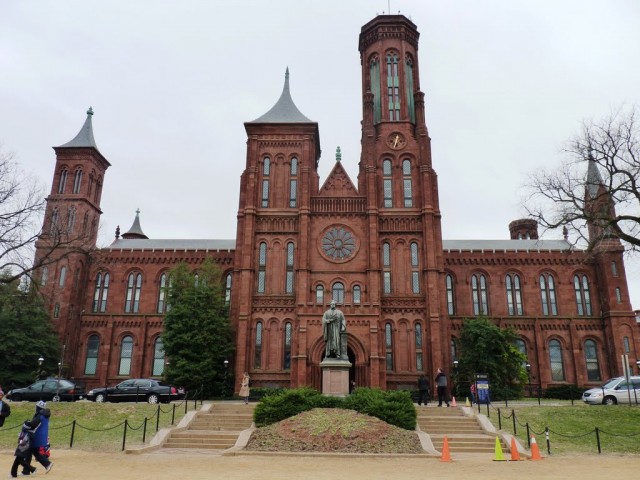 Where would you go to see The Spirit of St. Louis, the monoplane that, in 1927, bore Charles Lindbergh on the first nonstop flight from New York to Paris? How about Tony Hawk’s skateboard, which carried him to dozens of victories, to say nothing of a substantial fortune? The skull of a harbor seal sent from Oregon to President Thomas Jefferson by Meriwether Lewis and William Clark’s Corps of Discovery? Tito Puentes’s drums? Julia Child’s kitchen? Dorothy Gale’s ruby slippers?
Where would you go to see The Spirit of St. Louis, the monoplane that, in 1927, bore Charles Lindbergh on the first nonstop flight from New York to Paris? How about Tony Hawk’s skateboard, which carried him to dozens of victories, to say nothing of a substantial fortune? The skull of a harbor seal sent from Oregon to President Thomas Jefferson by Meriwether Lewis and William Clark’s Corps of Discovery? Tito Puentes’s drums? Julia Child’s kitchen? Dorothy Gale’s ruby slippers?
To see all these things, among millions of other artifacts—more than 176 million, at last count—you would travel to the Smithsonian Institution, an amalgamation of 19 museums and art galleries in the District of Columbia. To that number are added the sprawling National Zoo, as well as numerous research facilities and ancillary museums and storage facilities within and outside the District. The Smithsonian Institution is also first among equals in a network of affiliated museums that now numbers more than 175 institutions throughout the United States, as well as Puerto Rico and Panama.
The Smithsonian Institution (never, properly, Institute) is a place of superlatives. Collectively, it is the most heavily visited museum in the country, with more than 30 million visitors in 2012. Visitors to the most popular destination, the Air and Space Museum, inside which Lindbergh’s plane hangs from the ceiling, numbered more than 8 million in that year. That makes Air and Space the single most visited museum in North America, and though it sometimes vies with another Smithsonian branch, the Museum of Natural History, for that top honor, both usually stand within the top ten most visited museums anywhere in the world, their numbers not far behind the longtime winner, the Louvre in Paris.
The Smithsonian has a curious history to match those superlatives. Its origins lie in an unexpected bequest on the part of an English naturalist, James Smithson, who died in 1829. With no children of his own, and with no prior indication that he was going to do so, he gave the entirety of his estate—a sum amounting to about $500,000 today—to the United States of America, “to found at Washington, under the name of the Smithsonian Institution, an establishment for the increase and diffusion of knowledge.” It took 17 years to organize that establishment, but James Polk finally authorized the legislation that formally brought the Smithsonian into being it in 1846. (Smithson’s tomb, incidentally, is itself one of the exhibits on display.)
Those private origins have bearing on the Smithsonian today. The federal government funds the Smithsonian, but only partially: Its appropriation in 2013 was $775 million, and in 2014 it was $805 million—about 5 percent less than the amount requested of Congress. Admission to the Smithsonian is free, but a combination of commercial enterprises (including a magazine and cable network) and private donations brings in about a third again as much money. The Smithsonian typically returns a small surplus, with its reported earnings in 2013 about $1.3 billion.
This operational blend of private and public sources of funding is of long standing, reflecting the Smithsonian’s historic status as an “independent establishment in the executive branch,” as it is referred to in the Federal Property and Administrative Services Act of 1988. In practice, however, the Smithsonian is a charitable trust that operates more or less independently of the three branches of government, causing Supreme Court Chief Justice William Howard Taft to deem it “a private institution under the guardianship of the government.” Wise lawyers and jurists have despaired of placing the Smithsonian more precisely within the web of departments and agencies within the government, and though the Smithsonian is widely considered a federal agency, it is not entirely subject to the regulations governing federal property under the terms of that Act.
To be sure, it works closely with the General Services Administration in matters such as procuring physical plant improvements, building new structures and renovating existing ones, and the like. “We have to assume that we’re operating according to federal guidelines in things like awarding contracts to the lowest bidder,” remarks one Smithsonian official. “But then there are all sorts of variations in how we do things that come about precisely because we’re a trust. It really depends on what we’re doing, what we’re spending money on, and how much we’re spending. Getting clarity on this just isn’t easy, and it never has been.”
If clarity isn’t easy to attain, there’s much to administer: The Smithsonian employs more than 6,750 full-time workers, occupies at least 2.7 million square feet of space (the precise figure varies depending on whom you ask) in dozens of buildings, and generates annual revenues that would make many a corporation happy. Plus, it’s open every day but Christmas, so that there’s always something going on at the Smithsonian—a constant hub of activity, all devoted to that increase and diffusion of knowledge of which Mr. Smithson spoke.

